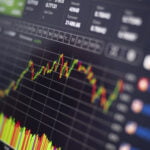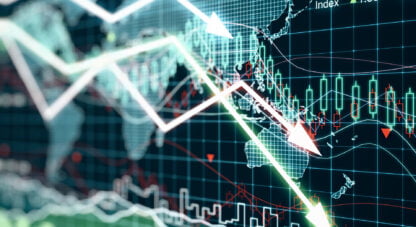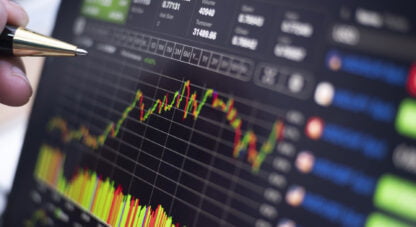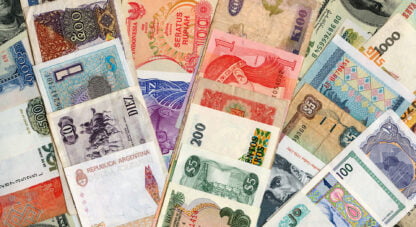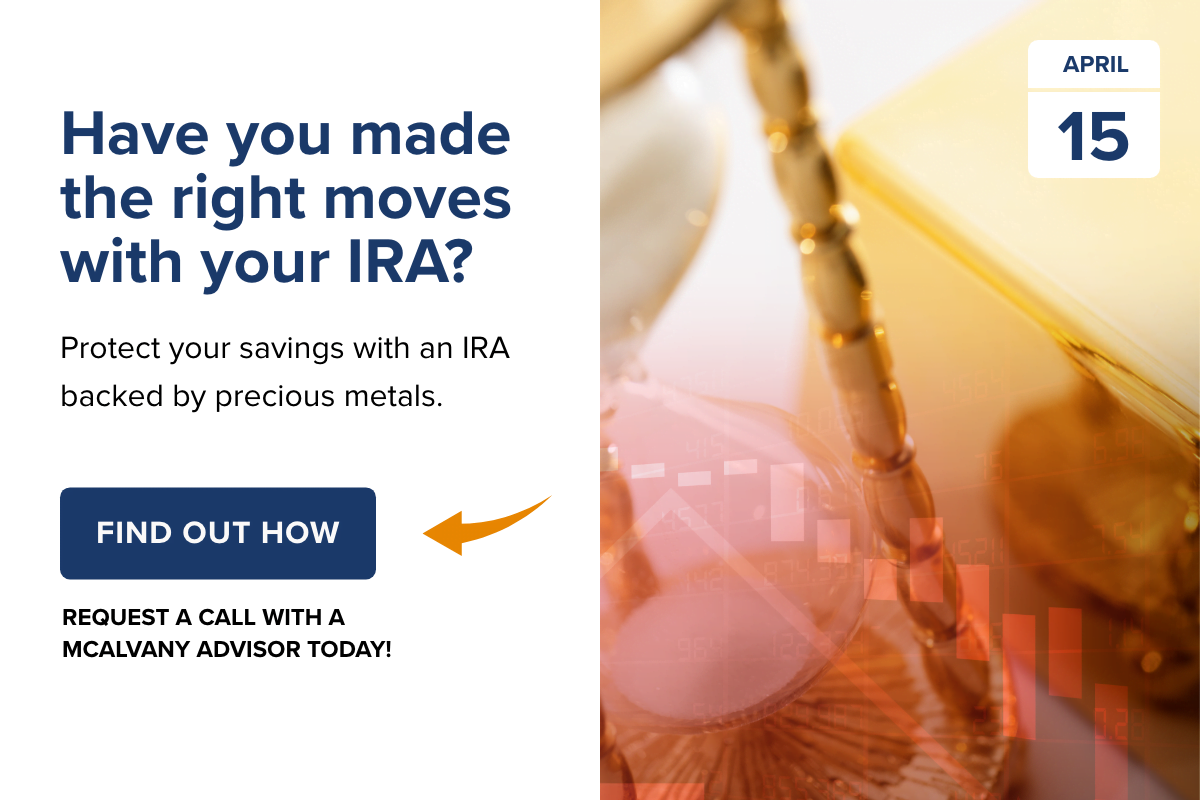Podcast: Play in new window
- Europe’s GREEN Agenda creates dependence on Putin’s energy
- U.S. severs buying of Russian Oil
- Battle-tested, gold is worth its weight
The McAlvany Weekly Commentary
with David McAlvany and Kevin Orrick
Is This Commodity Price Spike Transitory?
March 8, 2022
The key is to have the mindset of the institutions that will sit back and wait for weakness. And on every bit of weakness, they’ll add to a position. You don’t have go out and load the boat today, but you do have to recognize that there has been a massive change. A massive shift. The investment world is taking note of inflation stubbornness. They are recalibrating. If you don’t, you will find that you’re lost in the shadow of stagflation in the period ahead. — David McAlvany.
Kevin: Welcome to the McAlvany weekly commentary. I’m Kevin Orrick, along with David McAlvany.
Inflation. That seems to be on the minds of everyone. And Dave, before we start this program today, I’d like to read. You turn me onto a book by Barton Biggs called Wealth, War, and Wisdom. You’ll remember this paragraph, it’s on page 213, and it’s about the German hyperinflation back in the early 1920s. So here we go. Reading from Barton Biggs: “No chart can capture the stupendous ascent slope of true hyperinflation. Numbers actually do a better job. From 1919 to 1921, German CPI inflation was gradually rising from virtual price stability to a 2% annual rate. By June of 1922, inflation was at an annual rate of 4%. By September, 22%. By December, 68%. And then it really took off. In March 1923, it hit 285%, then 765% in June, 1,000,500% by September and finally 152,221,670,000% in December.”
Dave, I’m not saying we have hyperinflation, but look at the numbers over the last couple of days. Nickel, I mean, gold.
David: Yeah. I will make the case this time, and you’ll be surprised to hear it, but this is transitory.
Kevin: Very transitory. It’s going to go away tomorrow. Is it—
David: When you have war and price increases, which are, again, price increases that are conflict driven. You’re really talking about a force multiplier for an inflationary trend. We have inflation. We have had inflation, not just for the last 60 days or the last two weeks of the Russian and Ukrainian incursion, but we had a backdrop that was highly inflationary to begin with, and we’re moving towards 10% on the US CPI and 20% for the US PPI. Now we’re going to get there a lot faster because of this conflict. The conflict is transitory. This particular force multiplier for the inflation figures is transitory. Nickel going from 24,000 to 50,000 to 101,000 in a matter of 72 hours—
Kevin: Wow.
David: —is transitory. There are dynamics there which have nothing to do with the money supply. They have to do with someone who is short— a Chinese billionaire who is short the nickel market, and is being forced to cover with mark-to-market losses in the billions.
So it’s a unique dynamic with each of these commodities. You see wheat going through the roof, whereas other commodities are not because you are dealing with a particular geography, a particular conflict. And yes, when you look at Wealth, War and Wisdom, Biggs’s book, he chronicles how your worst-case scenarios are in fact, transitory. You can get through even a world war in a matter of two to three years, and then it is done. And then it is done. What makes this inflation so pervasive, and I think non-transitory is that it’s driven by money supply growth on a global basis. That it’s driven by money printing on the one hand, but also of fiscal policy maneuvers on a global basis. And that has served to create an inflation that is ubiquitous. And it’s not one particular commodity.
What we’re seeing now is the high drama of conflict. The high drama of war. We’ll get to gold in a minute, but on our way there, we first consider the 30% moves in crude. The 30% moves in palladium. The 10 to 20% moves in copper and zinc and aluminum and iron ore and nickel, just to name a few. And that’s just in a matter of days. The soft commodities are on a moonshot, and inflation, as we’ve said in previous weeks, like kryptonite, is crippling the financial markets.
These are destabilizing moves in so many ways, but you’re one headline away from radical reversals in price. Now I’m not suggesting that the underlying inflation trend is changing, but these radical moves that we’re seeing can be volatile the other direction too. I mean, today we were down 300 points and we turned on a dime. The Goldman Sachs short index is up 5% midday after being down earlier in the morning. These are radical moves, in part because of the backdrop that we’ve been describing for months now. You have the amount of derivatives in play. You have the amount of options being traded. You have the amount of speculation in motion, and you’re going to see high drama in both directions.
Kevin: Yeah, it’s interesting, Dave, I was asked this morning because gold was up pretty substantially, is everybody calling or, what’s the thought right now? And I said, what we’re really having to do is train them not to care about the price because just as much as gold can be up on a given day, it can be down on a given day too. That’s not really why we own it, but let’s move to these sanctions because now that we’re starting to see that the world, for the most part, has opted not to trade with Russia, that actually increases the effectiveness at least of the sanctions. Don’t you think?
David: Sure. And it’s a market-infused measure. There’s a magnification of the impact because you’re seeing sanctions enforced almost on a market level, where you have the central bank liquidity freeze, but now it’s alongside the commercial bank liquidity blockade.
Kevin: The credit cards.
David: Coupled with corporate boycotts from Boeing and MasterCard and Visa, that raises the stakes for Russia by increasing the costs to society for the war that Putin wanted. So all of these things combined, you’ve got the ruble, that’s fallen as much as 50% since the beginning of the year compared to the US dollar. It may fall as much as 70% before all is said and done. This is an inconvenience for Russians that has been transformed into a crisis because the cost of goods and services ratchets on a delayed basis with the devaluation.
Kevin: You know, but there’s always a strange irony. And the strange irony is that Russia is still taking in tens of millions of dollars, hundreds of millions of dollars for the oil that they’re providing with their so-called enemies.
David: Yeah. The most effective measure has remained off the table and only a hypothetical discussion point to this week, banning Russian oil and gas. And the reason is familiar. If you’re a parent, you’ll know what I’m talking about. When have to impose some disciplinary action, sometimes it infringes on the parent doling it out. You ground the child and you realize, wait a minute, I have to stay home with the grounded child.
Kevin: Right.
David: So I mean, the ban’s no different. You’ve got Europe that has 40% of its gas and between 25 and 30% of its oil imported from Russia. Some people in Europe are not bothered by that at all. I mean, a country like Spain is insulated with virtually no Russian gas flowing in, but then you’ve got Italy and Germany that are 40% players, and even more, much higher percentages going to Eastern European countries like Bulgaria and the Czech Republic.
Kevin: I wonder if we’re second guessing now. We’ve gone through at least a decade of looking towards renewables and the green agenda. At this point, are we seeing the weakness of getting rid of carbon just a little too soon before replacing it with renewables?
David: Yeah. And we saw this in the quarterly reports from your big oil companies over the last one to three quarters, where increased share buybacks, increased dividends. It was “a return of shareholder capital.” You always put that in quotes, but a return of shareholder capital and a huge capital discipline to not expand capacity, even though prices are rising. And so supplies and capacity are tight enough. Part of the reason for that has been a decade-long focus on renewables development and a massive push—and of course there’s political implications for those who are not on board with this—but a massive push for de-carbonization. That extra capacity for oil and gas is now not that easy to come by. So the result of hitting the Russians where it hurts most is that that consequence or those consequences can boomerang. Now, good news. If you look at Exxon Mobil, if you look at Chevron Texaco, they do have some US assets which over the course of the next 12 months are likely to bring on say 800,000 to 900,000 barrels per day, but that’s on a delayed basis too. I mean, by the end of the year, we’ll be in a better stead. By the end of the year.
Kevin: That feels a long ways away. You know, this reminds me—
David: Crisis is measured in moments in seconds, in minutes, in days, not in months and quarters.
Kevin: I was sailing a boat across the Gulf of Mexico with a guy. We were moving a boat for a man. We had a limited time schedule, and unfortunately the diesel motor didn’t work. So we were energy insecure. We were completely dependent on the sail. And it just happened to be a period of time where there was hardly any wind. So, in a way, what we’re seeing— Sure, would we have rather sailed that boat? Well, yeah, we had to sail the boat because that was all we had. We went down, tried to work on the diesel motor, but turns out it did not work. So we had had no other source. In this particular case, the analogy would be a carbon source. We had no other way of moving that boat. So we were in a way, energy insecure in the middle of the Gulf of Mexico.
David: I applaud your green sailing efforts. You had a very low carbon footprint, maybe with the exception of the carbon or fiberglass hull.
Kevin: Do you know how hard it is to maneuver a sailboat when there’s no wind, when you’re coming into port? You don’t have much maneuverability, but Europe right now doesn’t either.
David: And they’ve led the charge, set the standard for a green agenda, and revealed how energy insecure they’ve become in the process. It’s an unintended consequence, but the EU relies on imports to meet 60% of its energy needs. Germany is a massive energy consumer, partly because they are a massive product producer and distributor, but they chose to decommission all nuclear power plants some years ago, 26 in all. They’ve got three of the six remaining, which were wound down at the end of 2021. And the final three are closing this year. It’s kind of pure irony.
Kevin: Wow.
David: Terribly inconvenient scheduling. But the reality is the process of decommissioning cannot be reversed for safety reasons.
Kevin: And we use the word irony, but actually sometimes it’s just pure hypocrisy because they’ve been shutting down clean nuclear, and they’ve been replacing it with coal from Russia.
David: Well, and not necessarily replacing. Coal is one of their easier to decommission. And it’s a big chunky part of their energy creation. Nearly a quarter of all energy created in Germany is from coal. You’re right. 50% of Germany’s coal requirements come from Russia. It’s far dirtier. I’m not sure why they prioritized getting rid of nuclear first, except that they consider it to be incredibly dangerous. And of course, post Fukushima, that was an easy play, but coal plants as well are scheduled to be completely phased out by 2030.
So now you’re talking about having to replace another 24% of your energy production. In the near term, Germany is dependent on Russia—or if it’s not wanting to be, it’ll have to pivot hard to LNG. As we mentioned last week, you’ve got US liquid natural gas, liquefied natural gas, which meets some of the demand, but we’re still a few years away from Qatari capacity being sufficient to fill in the gaps and bring in more energy sufficiency to Europe, and specifically to Germany.
So the alternative is LNG in this interim or crisis period. They are paying considerably higher prices, and note how the US is willing to court the idea of cutting our oil, been very reluctant to do it so far, but now we’re getting some traction there. And Germany is still saying, no, thank you. I don’t think we’ll be doing that.
Kevin: So you could almost imagine that Putin’s wish down deep inside would be the green agenda of Europe. That weakened them. Didn’t it?
David: Well, there’s an interesting connection there. I mean, climate change politics have inadvertently elevated Putin stature and power in Europe via the energy markets. And you’re right, you might think that Putin could have wanted to fund the green movement for just such an outcome, harness the energy of idealistic youth to change the world in ways that favor your regime. Well, that’s never happened before. Never.
Kevin: Wow. Wow. So what would Greta say? You know—
David: WWGD, what would Greta do?
Kevin: What would Greta say, right? Yeah. What would Greta do right now, but okay. These other commodities, you named other commodities that are spiking right now, a lot of those come from Russia.
David: Well, it’s true. And, and again, back to the nickel issue. Of course it’s used in stainless steel, but you’re also talking lithium ion batteries. Well, what do you do if one of the key components in lithium ion batteries that rises 90% to $55,000 a metric ton, the highest in a 35-year history. And then all of a sudden, overnight it doubles from 55,000 to almost doubles to 101,000 before the London metals exchange shuts it down.
Kevin: Incredible, incredible.
David: When combined with all natural resources, speaking of Russia here. And so you include nickel and titanium and aluminum and palladium and gold and wheat and corn and vegetable oils. You’re at 60% of Russian GDP. I mean, this is what some have described as the resource curse. Well, right now it’s not so much a curse because revenues are up, but it’s a resource curse in the sense that a lot of countries that have rich natural resources fail to develop much of their other economic inputs. They could, but they choose not to because it’s just too easy.
Kevin: And Russia’s known as a resource country.
David: Of course. So restricting the flow on any of those resources, as is being entertained— And we’re beginning to see some of that where even the London Metals Bullion Association is no longer taking gold from Russian gold companies, LBMA will not take Russian gold. So restricting the flow of those resources impacts the market as the market searches for the right balance between supply and demand. Of course, what we’re seeing is the pressuring of prices higher. That is our current reality. It’s a commodity price explosion, which of course entails, as we mentioned earlier—and this is why I say it’s transitory. It entails a commodity price implosion on the other side of the trend. But when that occurs, no one knows. So in the meantime you have a short-term bonanza for Russia, unless or until there’s a ban on commodities from Russia.
Kevin: Okay. And you were talking about London not taking the Russian gold, but I’m sure that’s not going to bother Putin much because I’m sure China will be happy to take Russian gold. Not only does China produce most of the gold, but they don’t sell any. They end up buying about twice what they produce. So—
David: I don’t think it’s a disappointment. Polyus will definitely distribute gold to the Shanghai Gold Exchange. There’ll be no problem with delivery of bars.
But you know, this goes back to looking at how insulated they’ve been thus far. Consider the January current account surplus for Russia. It was 19 billion, about 50% higher than a typical January.
Kevin: That’s before the invasion. So they had an account surplus of 19 billion.
David: But this is— your monthly averages are somewhere between nine and 12, and 19 is about 50% higher than a typical January.
Kevin: Was that because oil was higher?
David: Oil was averaging, through the month of January, about $86 a barrel. So not at the elevated prices we have, but higher than we have seen in recent years. Now we’ve got February at even higher prices, and early March at higher prices still. What do you think February will look like as we get the numbers in for the current account surplus for Russia? 20, 25 billion? I mean, Russia is printing money even as we restrict its money flows because commodity prices and resource revenues are through the roof. That can end, of course, but when it ends, it comes at a very high cost to everyone else in the world. Again, limit commodity flows and prices go higher. So far what we’ve seen is not a limit in commodity flows, but the idea that they could be limited. And that has been sufficient to tease out in investors’ minds what the implications would be, and lo and behold prices are higher.
Kevin: So if you had to make a prediction, is the next shoe to drop banning energy from Russia? I mean oil and gas?
David: It’s going to be a very tricky thing to determine. Scott Sheffield, who’s the CEO of Pioneer Natural Resources, suggested to the Financial Times last week that if you banned energy from Russia, you push oil to between $150 and $200 a barrel. So you can imagine the global impact. You can imagine inflation rates everywhere shifting from rising single digit to clearly double digit levels. You can imagine household sentiment shifting to new lows, and in the emerging markets where food instability is always one day away, now you’re talking about food crisis dynamics reemerging, like what gave rise to the Arab Spring and the Tunisian fruit vendor’s self immolation, which sparked a wildfire of regime change throughout the Middle East. War, famine, pestilence. They drive commodity prices berserk. And when commodity prices go berserk, sometimes people follow suit. So rising commodity prices drive social and economic insecurity, which in turn drives political volatility, right? And it’s just what we need now on a global basis.
Kevin: It’s really shocking. We were driving through New Mexico this weekend, and a refinery, this was a natural gas refinery that we see all the time as we drive down there. There was no flame on the top, there were no cars, there was nobody there. It was a big refinery that was completely deserted. And in a way it was sort of a metaphor for what we’ve done energy-wise at exactly the wrong time. So what would impact— if we did cut out Russian oil to the United States, what does that look like?
David: Yeah. To ban Russian oil in the US, there’d be a large impact at the pump, in part because of what we import from Russia, because it fits refining setup for specific types of crude. If you’ve got light sweet, that goes to the west coast. If you’ve got heavier crudes, they go to the Gulf coast. The flows of oil and the oil imports are specific to a refinery’s complexity. And so it’s not like, oh, we’re not going to bring in Russian oil. We can just pick up oil from someone else. Well, it has to be the right kind of oil to come into the right refinery to be turned into the products that we need. So they’re not perfectly replaceable. If you’re going to other countries, even if capacity existed in those other countries, you’re still dealing with— well, it’s something comparable, well, with what we’ve talked about for the last year and a half: supply chain bottlenecks. Well, this is a refining bottleneck.
Kevin: Are we starting to make new friends, neighbors that used to be our enemies are now becoming our newest friends now that it’s looking like we may not get oil from Russia?
David: Sanctions on Venezuela in 2019, we’ll make those go away if you’ll help us. There’s been some talk about, actually, Venezuela and Iran filling those gaps. And we’ve sent emissaries to both places for talks, but I don’t think that’s actually what it’s about. I think that capacity from Iran is largely called for by the Chinese. What we’re doing there is we’re negotiating the nuclear deal from a position of weakness in Iran, with hopes that their growing accumulation of higher grade fissile, that is uranium and radioactive materials, doesn’t become yet another source geopolitical insecurity. And oddly enough, if you can imagine this, we have sort of this peripheral engagement with Russia as the “enemy.” No, we haven’t exactly aligned ourselves with Ukraine, but at least from a rhetorical standpoint, we have. We’re leaning on the Russians for help in getting the nuclear deal across the finish line with Iran.
Kevin: Wow.
David: They’re helping negotiate it as we speak.
Kevin: Wow. Strange ties.
David: The world might benefit from there being more Iranian crude with a reduction in prices. But the actual flows of oil, availability of product, continues to be largely China bound, right? So we can negotiate something, free up new supply, and guess who’s the beneficiary? China. And on that point of Venezuela, Venezuela lacks spare capacity in the short run.
Kevin: You brought that up on the Neil Cavuto show on Fox a couple of days ago.
David: Yeah. The idea is that we’re just shaking every tree to see what falls out.
Kevin: And by the way, I don’t know how your chess is, but Gary Kasparov was the guy right before you that Cavuto interviewed, and then General Boykin was right afterwards. So how’s your strategic end of things? You were talking about oil, but you’ve got a chess champion, Kasparov, and General Boykin.
David: Well, I’ve never felt more like a queen in my life.
Kevin: You better explain that. How have you been feeling like a queen?
David: You’ve played chess before, right?
Kevin: Right. Right.
David: You get the pawn. All I am is a pawn. You get a pawn all the way across the board. So pawn moves to G8 from G7, and you get a promotion.
Kevin: That’s right. And you would, you’d turn it into a queen. Of course you would. Yeah.
David: So on the stage with Kasparov and Boykin, I did feel a little like a queen.
Kevin: Well, it was a compliment that you got to just be right in between those two. And it was good because I think one of the things we have to look at, too, is there are places that have excess oil if they just want to turn on the spigots. I mean, we can go back for the last 30, 40, 50 years. OPEC has controlled the spigots of the Middle East.
David: But isn’t it fascinating? Officially we don’t recognize Maduro as the president of Venezuela, and yet that’s who we’re negotiating with. So you get a little bit of a contradiction there, but I think we’re reaching out to Venezuela as an original OPEC member to negotiate something, again, negotiate something on the side with Maduro, which might influence him to swing the NOPEC vote in favor of increasing member flows to us.
I mean, I’m talking about OPEC, but currently you could call them NOPEC because they basically thumbed their nose at us and said, unh-unh. We’re not increasing the capacity. We’re not increasing the flows. So if they say yes, if OPEC agrees to increase supplies, you do have spare capacity with Saudi Arabia, with United Arab Emirates, with Kuwait, with Iraq, and with Azerbaijan. There’s a couple of non OPEC members that could bump output a little bit, but we’re not talking about significant amounts: Brazil, Norway, Guyana. I mean, trickles, trickles. And we need something of a flood to bring us out of the 130s, 120s on its way to 150 or 200.
Kevin: So to discourage Putin, that’s why the United States said no more oil from Russia.
David: Yeah. It appears the US is going to now diverge from Europe, and we’ll end Russian imports. And this was an observation I made with Neil. We’re sending them $50 to $75 million a day, that’s to the Russians. We’re sending them $1.5 to $2.25 billion a month at the current level of imports, which is 400,000 to 600,000 barrels a day. And that appears to be ending this week. Good. That’s good. Now comes the bad news. Inflation expectations are officially unhinged.
Kevin: Okay. So we’ve got all this crisis going on, and you had an interesting theory we were talking about last night. You said, there are a few things that could change this pretty dramatically. One of them, and I wouldn’t have even thought of this, is Xi Xinping. Could he step in on a white horse and say, we’re going to negotiate, or we’re going to broker a deal that’s going to solve this problem? What does that change if that were to happen? And is that even a possibility?
David: Yeah. In that sense, we’re a headline away from that major move, lower in the commodity prices that are capturing the headlines today with their eye-popping numbers. So the only way that you can bring those inflation expectations back would be a Xi Jinping-brokered peace deal in Ukraine.
Kevin: Wow. How strange would that be?
David: Without that, Russia is likely to retaliate. Retaliate to what we’re doing. We’re now shutting off oil imports from them. How can they retaliate and increase pressure to Europe, and certainly raise some social tensions between the US and Europe, because Scholz over in Germany has made it clear. He’s not going to do this. Right? So just shut down Nord Stream 1 and force a pure, full blown energy crisis in Europe. Bring that to a head. Talk about recalibrating Xi Jinping’s global standing. Overnight he can go from partner of pariah Putin to prince of peace. Right?
And of course I haven’t a clue what he wants. I don’t know how he wants to be remembered, but that theory of Xi fixing what is unfixable. We’re going to the brink of war. We’ve put nuclear on the table. There’s nothing that is out of the imagination at this point. And the whole global community sees the chaos that’s unfolding, and now prices are going absolutely bananas. And here’s a man with a plan. Here’s a solution. And he’ll be always remembered as the man who brought peace in 2022. That’s theoretical, I don’t know if that happens, but I don’t know how we back away from escalation.
Kevin: You know, that is also a discouragement for the person who— we would discourage going leveraged on things like these commodities moves. I mean, look at what happened to the Chinese billionaire with nickel just over the last few days. So no leverage because things can change very quickly and the unexpected can happen, but let’s look at what can be expected. Okay?
David: Yeah.
Kevin: Gas prices are probably going to stay high for a while.
David: This is the tricky part.
Kevin: That affects everything else down the chain, doesn’t it?
David: Sure. That’s the tricky part because high gas prices are the consumer’s nemesis. All discretionary spending is at risk when prices at the pump begin to invade the pocket book. So without a substitute for Russian oil, these higher prices are going to be with us for a while. We already have seven and a half percent for the CPI, Consumer Price Index. This week we’re going to have a better look at it for it to go well above eight, no surprise. Could we see double digits by the end of the year?
Kevin: How about the Producer Price Index? We said it was already close to 10%.
David: And I think you can register 20% this year. Anything that pushes the trend further has political consequences for the Democrats in the midterm elections. The Catch 22 is, you can’t be funding the Russians. So if you’re not going to fund the Russians, where are you going to get the oil from? Where are you going to get it from? Venezuela doesn’t have spare capacity. Iran doesn’t have spare capacity. I mean, you could go to Alberta. That’s a possibility. You can smooch up with the CEOs of Exxon Mobil and Chevron Texaco. And maybe they accelerate a little bit more drilling in the shale patch, maybe. But so far— And we’ve talked about this before. An 11, 12% increase in rig count has happened, and we’re still seeing a decline in production from 11.8 to 11.6 million barrels per day production here in the United States, even as we’re increasing rig count. So I’m not an optimist when it comes to US supplies coming on stream that fast. If Exxon Mobil and CVX, Chevron Texaco, think they can bring it by year-end, that’s probably a realistic timeframe. But there is a gap in the high gas prices that consumers pay. It’s now, it’s tomorrow, it’s this week, it’s this weekend. It’s coming into driving season this summer. And it’s highly consequential coming into a November election season. That’s a long ways away in terms of being able to deliver 800,000, 900,000 barrels of oil a day.
Kevin: Yeah. As I look at this inflation, I was thinking about the difference. You know, I started with a quote about German hyperinflation, but guess what? That was German hyperinflation. There was still a rest of the world that didn’t have hyperinflation. At this point, these commodity prices are affecting GDPs globally. I’m wondering, what kind of slowdown do we see because of the rising commodity prices globally?
David: In the UK, the Group National Institute for Economic and Social Research, it’s an economic think tank. They estimate that the conflict in Ukraine has already shaved off about a trillion dollars in global GDP and is likely to add 3% to global inflation this year. A little less worse next year, 2% in 2023. And it remains to be seen how high various input costs will go. Watch your PPI and numbers, your producer price indexes to see kind of what’s in line for the consumer to pay thereafter. But so far the only cap for commodity prices has been my imagination, your imagination, our imagination.
Kevin: Well, look at yesterday morning, I mean, yesterday morning with nickel going just haywire.
David: Woke up to the London Metals Exchange suspending nickel trading after an overnight doubling in price. Last week, we hit huge numbers, 25,000 per metric ton, Monday this week, 48,000. Then in less than 24 hours later, 101,000 per metric ton in one of the most epic short squeezes of all time. But this is what I’m saying. This is not a supply and demand driven, fundamental case for nickel. This is a Chinese billionaire who had built a massive short position in nickel and is covering his position with billions in mark-to-market losses. Right. And he is being forced to do so. So I think we’ve got a new joke. How do you make a millionaire in China? You start with billions and short the nickel market just before Russia, the largest global producer, goes to war. It’s like the old joke on how to make a million dollars in the restaurant business: start with two.
Kevin: Well, yeah. And this is why, don’t leverage these markets. You know, I mean, when you were on Cavuto, Brent crude was screaming up to about 136 bucks a barrel. I mean, we could see larger numbers if things continue the way they are.
David: Yeah. A week ago Brent was at a hundred, then at 130, a hundred, almost 140. And without a shift towards peace negotiations, and if we have continued escalation, then we get to JP Morgan’s projected numbers. 185, we get the Sheffield’s projected numbers, 200. Maybe they get surpassed. Putin says, cut supplies from Nord Stream 1 and the price can go to 300—only because he knows Nord Stream 1 would be one of his retaliatory measures.
Kevin: So for the person who’s listening, they’re going to say, okay, this sounds incredibly dire. How are the safe havens doing? I mean, where does a person go? I mean, we know that gold is one of them, but how are the safe havens doing right now during this period of time?
David: They’re doing well. I mean, gold has clearly done well, but I’d say its also been displaced. It’s been displaced as an inflation hedge. We’ve found a far superior method of hedging inflation.
Kevin: Oh, I’m looking forward to— So if something, after 4,000 years we found something superior to gold?
David: Digital gold, bitcoin. It’s the go-to safe haven in times of political and geopolitical turmoil.
Kevin: Oops.
David: It’s performed incredibly well this year. Oops, oops. Oh. Yeah. Sorry.
Kevin: I’m sorry. I’ll help you out on this, but no, bitcoin has not replaced gold.
David: Okay. So it’s off 20% since the beginning of the year. Its performance is strangely like technology shares. If you look at the Nasdaq-100 and you look at the way that bitcoin and ethereum have traded, maybe it’s an expression of risk appetite and speculation. After all, I do not doubt it will have another day in the sun. But to be clear, it’ll have its day in the sun as an expression of speculation. It’s not the new gold. That is now an established fact, right. Ethereum is off a third, a little bit more than Bitcoin, not just since the beginning of the year.
Kevin: Okay. But seriously. So let’s talk about the larger, safe havens, you’re right. Blockchain technology has its place. It’s been more on the risk side, more on the speculative side, but people have to know where they’re going to move their money, where they’re going to have it tomorrow and have it buy something tomorrow.
David: Yeah. And I mean, in recent weeks, you’ve had massive yield compression in Treasurys and in German bunds. Very significant, but even there, massive volatility. I mean, to see the kinds of moves in both directions, it suggests that there’s some significant hemorrhaging. There’s some significant leveraged players who are foundering as a result of this volatility. So volatility feeds volatility, both on the upside and on the downside.
Yes. There have been massive flows into those safe havens, even peripheral European bonds over the last week or two have exhibited more safe haven qualities, at least of late. But the metals do shine under pressure. They’ve had an impressive run, year to date. We’re now well over 10% in terms of the gains for gold, about 12½ percent to be precise. And silver’s almost 15% year to date on the positive side. Our hard asset strategies are nearly double digit, and that’s with 30 to 40% cash allocations. So we’re finally seeing institutions like pension funds and insurance companies migrate their first dollars into the metals.
Kevin: Well, and I was going to ask you about that because for years we’ve explained to people, it may have come from your dad. It may have come from you. I can’t remember, but there are three layers to a gold bull market. The first layer is just the dyed-in-the-wool people, and they’re buying small amounts of gold. The next layer is the financial markets. When Wall Street starts to get interested in gold, the financial markets start to come in. But then there’s this third layer where it becomes generally acceptable to a very large audience, including large institutions, pension funds, hedge funds, what have you. So are we moving into that third phase? Are we moving into that generally acceptable, where it’s not just, oh, we’re going to go buy stocks. No, we’re going to buy some gold.
David: Yeah. I mean, we saw in the cyclical bull market of 2002 to 2011, we saw the contrarian and the maverick step in before it was clearly established that a price—
Kevin: The gold bug.
David: The trend had been established.
Kevin: Yeah. The gold bug. Yeah.
David: But they looked and they said it’s uncharacteristic for a central bank, like the bank of England, to dump gold. And sure enough, we did set a floor with Gordon Brown’s dumping of British gold. He took it to $252.
Kevin: He picked a bottom, he picked a bottom.
David: He put in the floor. And so the contrarian and the speculator of phase one, you began to see products proliferate from Wall Street firms in 2003 and ’4 and ’5, where they said, the trend has now changed. And we’d like to be able to monetize that, offer something to clients. And it was meeting demand. When clients call and you don’t have anything, you put together the product that they’re asking for, and that’s what Wall Street did. And then, in that particular bull phase, you ended up in the 2009, ’10 and ’11 —the tail end of it is when the speculator comes in, the Johnny come lately, the general public. And lo and behold, it’s the fall of 2010 or the spring of 2011, Barron’s runs an article, right? You’ve got to own it. It’s one of the best asset classes to own.
Kevin: And then by August or September I think we hit our high, didn’t we?
David: That’s right. So it was that phase of contrarian to Wall Street firm to speculator, man in the street. And we’ve just come through basically a 10-year consolidation of cyclical bear market in gold, in which case the speculator might have picked off the price at 2015 levels or 2016 or ’17 levels between 1,000 and $1,300 ounce. Wall Street is beginning to take positions. And to your point earlier, we are beginning to see very constructive and large interests come into the market for the first time in this cycle, where pension funds and insurance companies are beginning to take some allocations and buying gold. And they’re buying by the gram relative to what they have in their portfolio and technology stocks and everything else, or fixed income for that matter. They’re not buying by the ton. They’re only buying by the gram. They think it’s adequate to be dosing it out with a teaspoon, right?
Kevin: Well, and even with them buying, though, we should expect volatile days, but are we thinking maybe that they will be buyers on those volatile days where we start see it dropping?
David: I think there will be for sure. But the idea that the moves that we’re seeing now are driven in some sort of a speculative blow off. Yes. Certainly, if you’re talking about a time measurement that is this week or next week. Momentum is in play, we’re above 2000. We’re going to go back to test the old time highs between 2060 and 2090. And once we’ve done that, expecting a consolidation would be natural, would be normal to see the price back off. I don’t know where we test on the downside from there.
But to your point, you’d now have a change of mind. Institutions want to own it. And if it gets cheap, they’re going to buy—maybe not with a spoonful this time. Maybe with a shovel, and maybe they back up the truck at some point. But what I’m saying is, the only speculators who are driving price today, or this week, to high levels, and at a very fast clip, are hedge funds and asset managers who are pretty fickle in their positioning. They buy today, sell tomorrow. There is a difference in quality when you’re talking about an institution like an insurance company or a pension fund. They are your buy-and-hold crowd. They’re not your traders. Right?
And what I am saying as well is that there is a reserve of clients, a cache of future gold buyers, that are still stuck in technology shares, stuck in the Dow, stuck in their index funds. And they still believe that we’re in an ongoing equity and bond bull market. When they are disabused of that idea, when they come out of those positions, when any of that money in the classic 60/40 portfolio migrates in the direction of gold, then you begin to see the tail-end market fireworks that are characteristic of the last speculator, not the early contrarian, not the mid-market constructive Wall Street interest, but now the Johnny come lately. We’ll see it once again. We saw it in 2011. We’re probably 2, 3, 4 years out from that.
Kevin: So what you’re really talking about, though, is we’re seeing a large scale structural shift in those who are buying gold.
David: Absolutely. It is a structural shift in the metals complex, and it’s a structural shift in the investment world—not just in the US market, but in the investment world. Think about the difference between Disneyland and Disney World, slightly different scope. The investment world is taking note of inflation’s stubbornness, and they’re recalibrating. It’s the shadow of stagflation that’s being cast across all asset classes this week as central banks are facing what is a worst-case dilemma. You’ve got slowing economic growth which is complicated by war, a massive negative psychology attaching itself to the business community as a result of the unforeseeable future.
Again, conflict does this to the feeling in the market and the psychology in the market. On top of that, you have rising inflation, so massively accelerating inflation. What does a central banker do? How do you maintain credibility? You want to remain accommodative because an economy may in fact be foundering, but you can’t be accommodative because inflation is already in full effect, right? So again, you bring in the negative psychology permeating the market due to war. They are in a real bind. Do you know what that means? It means, as we were just talking about, all weakness be bought by large interests.
Kevin: Well, see, that’s what I’m talking about. The Disneyland Disney World analogy, that’s a pretty good analogy because you’re talking about buyers, not just psychology buying gold, but you’re talking about consistent buyers that have a consistent strategy.
David: And it’s a different scope. It’s for a different reason. It’s not buying today to sell tomorrow, to make a quick buck. It’s looking and saying, if inflation is pervasive, if inflation is persistent, we need to consider repositioning because being long equities and bonds is not sufficient. What worked in the past will not work in the future. We have to consider the direction that we’re going and pivot.
So you have a financial market pivot afoot, and that’s, I think, what we’re beginning to see. We’re at the front edge of that in terms of a commodity shift, a shift in the direction of hard assets, a shift in the direction of things like oil, and yes, some of these moves are being exaggerated by the conflict with Russia and Ukraine. When that is over, we’ll see downside volatility across the commodities complex, including in gold and silver. But what has shifted for a long period of time ahead, five years, 10 years, maybe 20 years, is that financial assets now have a hurdle that they cannot get over. And for portfolio outperformance, there has to be an augmentation that gives some support with inflation now being in the context more or less permanently. Permanently in terms of 5, 10, 20 year context.
Kevin: In layman’s terms, in layman’s terms, own stuff.
David: Yeah. Own stuff.
Kevin: Own stuff.
David: Own stuff. Yeah.
Kevin: Yeah.
David: I mean, through our Vaulted program, you’ve got access, immediate positioning announces, incredible pricing. If you’re looking to see growth beyond the protected savings aspects of a program like Vaulted or the long-term benefits of having physical metals in your possession or in an IRA where you can actually trade the metals on a tax efficient basis. I mean, come on, this is brilliant stuff.
But if you want to go beyond that to something that is purely growth, look at your top tier metals miners over the next 12 to 24 months. You will regret not owning them. Now, the key is to have the mindset of the institutions that will sit back and wait for weakness. And on every bit of weakness, they’ll add to a position. You don’t have to go out and load the boat today, but you do have to recognize that there has been a massive change. A massive shift. The investment world is taking note of inflation’s stubbornness. They are recalibrating. If you don’t, you will find that you’re lost in the shadow of stagflation in the period ahead.
Kevin: You’ve been listening to the McAlvany weekly commentary. I’m Kevin Orrick, along with David McAlvany. You can find us @mcalvany.com, M-C-A-L-V-A-N-Y.com. And you can call us at 800 525-9556.
This has been the McAlvany weekly commentary. The views expressed should not be considered to be a solicitation or a recommendation for your investment portfolio. You should consult a professional financial advisor to assess your suitability for risk and investment. Join us again next week for a new edition of the McAlvany weekly commentary.




